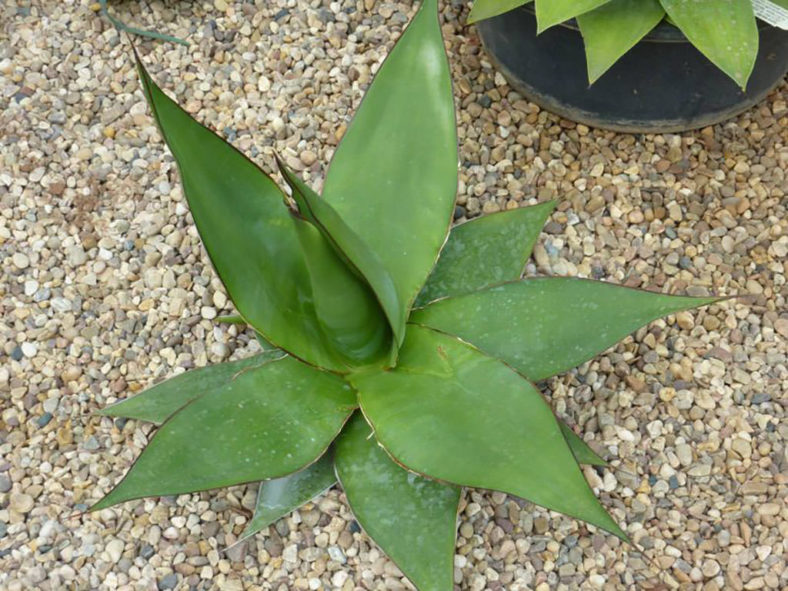Scientific Name
Agave chazaroi A.Vázquez & O.M.Valencia
Scientific Classification
Family: Asparagaceae
Subfamily: Agavoideae
Genus: Agave
Etymology
The specific epithet "chazaroi (cha-ZAR-oh-ee)" honors Miguel Cházaro-Basañez (fl. 2002), a Mexican botanist and specialist in the Crassulaceae family and parasitic plants.
Origin
Agave chazaroi is native to Mexico. It occurs near Tequila in Jalisco on cliffs in the tropical deciduous forest at elevations that range from 2,950 to 3,940 feet (900 to 1,200 m).
Description
Agave chazaroi is a beautiful succulent that forms a solitary rosette of broad, spreading, yellow-green leaves with narrow, reddish-brown margins and a long, sharp terminal spine. The rosettes can grow up to 32 inches (80 cm) tall and 5 feet (1.5 m) in diameter. The leaves are broadest in the middle, measuring up to 32 inches (80 cm) long and 8 inches (20 cm) wide. The younger leaves are glossy deep green. The older ones are nearly spineless, with only small teeth-like spines near the base.
The yellowish-green flowers appear on an unbranched stalk that can grow up to 8.2 feet (2.5 m) tall, usually in spring. The flowers can reach up to 1.2 inches (3 cm) in length. The rosette dies after flowering.

How to Grow and Care for Agave chazaroi
Light: Like all Agaves, this plant requires full sun to partial shade. If growing A. chazaroi indoors, choose a bright, sunny window with as much sun as possible. From spring to fall, it loves going outside.
Soil: A. chazaroi will tolerate most soils as long as they have good drainage, but it prefers sandy or rocky soil.
Temperature: During the growing season, it likes warm temperatures, while in winter, when resting, this succulent enjoys cooler temperatures. A. chazaroi can withstand temperatures as low as 30 °F (-1.1 °C). USDA Plant Hardiness Zones 10a to 11b, 30 to 50 °F (-1.1 to 10 °C).
Watering: From spring to fall, water thoroughly when the soil becomes dry. In winter, water sparingly about once a month. Plants in containers require more frequent watering than those in the ground.
Fertilizing: Give your A. chazaroi a small amount of fertilizer in the spring during the first two years. After that, established plants seem to take care of themselves.
Repotting: If you notice your A. chazaroi becoming pot-bound, repot it with fresh soil in a pot slightly larger than the old one. Give the plant a week or so to readjust before you water it again.
Propagation: Since a plant with a solitary growth habit, A. chazaroi can be propagated only from seeds.
Learn more at How to Grow and Care for Agave.
Toxicity of Agave chazaroi
A. chazaroi is not toxic to humans but may be mildly poisonous to children and pets.
Links
- Back to genus Agave
- Succupedia: Browse succulents by Scientific Name, Common Name, Genus, Family, USDA Hardiness Zone, Origin, or cacti by Genus
Photo Gallery
Click on a photo to see a larger version.


